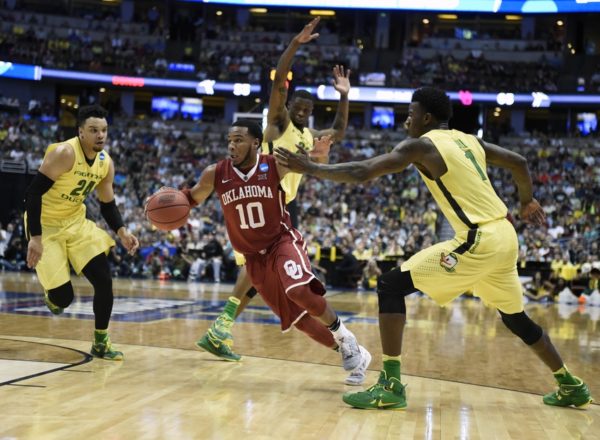One Burning Question: Can Jordan Woodard Carry Oklahoma?
Posted by Chris Stone on October 27th, 2016March is sadistic. For all but one school, the month — and the few days of April we tend to group with it — inevitably ends in sorrow. For some teams like Texas or USC, that ending is abrupt, brought on by last second heroics that put an end to a once-promising season. For others, the ending is an excruciating wait. So it was for Oklahoma last season. Midway through the campaign, the Sooners were the top-ranked team in the AP poll. By the end of it, they had made the school’s first Final Four since 2002. In Houston, though, Oklahoma was steamrolled, losing to eventual national champion Villanova by the largest margin in Final Four history. With each missed three-pointer, the conclusion became clearer. It was like watching a car accident in slow motion.

Jordean Woodard will have the keys to the engine with Buddy Buckets now gone. (USA TODAY Sports)
Now, Lon Kruger‘s team will have to rebuild its proverbial car and the model will look substantially different than last season. Gone are starters Buddy Hield, Isaiah Cousins and Ryan Spangler. The NPOY Hield, of course, will leave the biggest shoes to fill, but Cousins was a dogged defender and effective three-point shooter while Spangler was an experienced stretch four who brought a certain toughness to the team. Gone are 66.5 percent of the team’s total scoring and 59.2 percent of its total minutes played. Also gone is 7’0″ center Akolda Manyang, a potentially valuable rotation piece who was dismissed after being arrested for aggravated robbery. With so much of its Final Four roster no longer residing in Norman, Kruger will put one of his returning upperclassmen into the driver’s seat of the new model.
The keys to the Sooners’ reformulated roster will be passed from Hield to his backcourt running mate last season, rising senior Jordan Woodard. The 6’0″ guard finished second on the team in scoring in 2015-16, averaging a solid 13.0 points per game and connecting on 45.5 percent of his three-point attempts. Woodard also finished second on the team in assists and led the Sooners in steals. The 20-year old shined playing off the ball as a junior (Cousins took the primary ball-handling duties), but now he figures to be tasked with running the offense while also representing the team’s best scoring option. Shouldering that burden would be a difficult task for almost any college player and there are signs that it will be a tough transition for Woodard as well.
As a sophomore, he struggled to score as the team’s lead guard, which is the exact same role he’ll play this season. Woodard averaged just 9.3 points per game and made a meager 36.1 percent of his field goal attempts. As a junior, Hield’s gravity effect was a significant factor in creating his open shots, but Oklahoma’s offense sputtered when Woodard was on the floor and Hield was on the bench — according to HoopLens, the Sooners averaged only 1.02 points per possession (PPP) in the former situation compared with 1.16 PPP with both of them on the court. Woodard’s shaky history as the primary option doesn’t rule out future success, though. Kruger expects his leader to become more assertive in his new role and junior Khadeem Lattin will be there to help him out. He and Woodard could form one of the Big 12’s more intriguing pick-and-roll combinations, but it will ultimately be the senior who will be counted on to take responsibility. As the team’s point guard, he’ll be asked to direct the traffic on the court while driving the Sooners’ remodeled roster toward another NCAA Tournament berth.









































